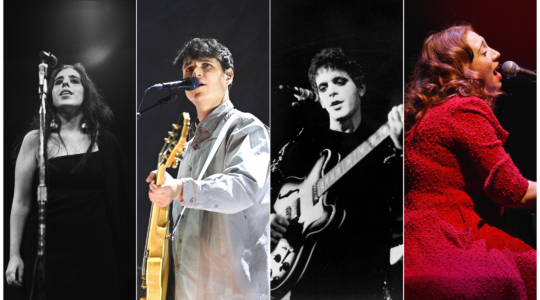As a young boy, Art Spiegelman would copy cartoon strips about Little Lulu and Donald Duck. By 14, he was illustrating his own stories with homemade comics, and at 15 he created and distributed his own satire magazine, Blasé. The magazine had edge; a young woman on the cover of a 1964 edition is asked, “What’s a nice girl like you doing on a cover like this?”
Some of this early work is exhibited as part of “Art Spiegelman’s Co-Mix: A Retrospective” at The Jewish Museum. Signed “Arthur Spiegelman,” his earliest work is inspired by the magazine he says he studied the way others studied the Talmud — Harvey Kurtzman’s Mad magazine. He has called Mad his “portal to America.”
Spiegelman, who turns 66 next month, is best known for his Pulitzer Prize-winning graphic work on the Holocaust, “Maus,” and remains active as a writer, artist and commentator. He has also collaborated with jazz composer Phillip Johnston on “Wordless! Words/Music/Comix,” a lecture on novels in pictures with live musical accompaniment. In the work, which will be presented this weekend at BAM, Johnston debuts a score with his sextet, and Spiegelman speaks about the first graphic novels published.
When asked at a press opening of The Jewish Museum exhibit about having a retrospective in the middle of his career, he quoted the late Abstract Expressionist painter Willem de Kooning, who advised never to have a retrospective while still alive. But de Kooning actually had two.
The exhibition was produced in France, and exhibited there (in Angouleme and Paris), Cologne, Germany and Vancouver, Canada before New York. In the title, the verb “co-mix” means to mix together, as in words and pictures.
Along with the early comics, the vibrant show includes five decades of sketches, notebooks, colorful graphics Spiegelman did for Topps Chewing Gum (“Wacky Packages” and “Garbage Pail Kids”), a comic strip he did for Playboy called “Ed Head,” issues of the magazine RAW that he launched with his wife Francoise Mouly, covers for The New Yorker, graphic essays, children’s books, broadsheets and “Maus”-related materials, such as archival photos and a stuffed toy mouse used as a model. The show stands out for its breadth of coverage of Spiegelman’s pioneering career, and for the emotional depth inherent in much of the work. To walk through the show and read the text panels and balloons in the strips is to glimpse Spiegelman’s world.
The centerpiece of the show is “Maus,” based on the wartime experience of his parents, Anja and Vladek Spiegelman. Here, Jews are depicted as mice and the Germans as cats. “Maus I” is presented in reproduction facsimiles, in a grid arrangement on one wall. The original manuscript of “Maus II” envelops the viewer, in a series of panels that snakes around three walls — and part of a fourth — of a long inset space in the gallery. Sketches of earlier versions of some panels — including detailed images of a mouse named Mandelbaum — whose concentration camp pants were so big that he had to hold them up with one hand — appear above and beneath the manuscript. Nearby, a recording plays Spiegelman’s interview with his father speaking in accented English. The viewer not only sees but hears additional layers of the story.
When Spiegelman began planning “Maus” — he worked on the project for 13 years, expanding a comic strip he published in RAW in 1972 — he says he was searching for a style “somewhere between intimacy of handwriting and clarity of typography.” The book became an international bestseller, translated into 26 languages.
The cover of “Maus I,” published in 1986, features two mice huddled together under a swastika. A photo shows Mouly and a friend posing in the same position. In another photo, Spiegelman is standing at the gates of Auschwitz.
Asked by a German journalist whether he thought that a comic book about Auschwitz was in bad taste, he replied, “No, I thought Auschwitz was in bad taste.”
In works of sequential art before and after “Maus,” Spiegelman often delved into themes of memory and history. His drawn bubbles and narrator panels feature powerful text in all capital letters — always honest, whether funny, dark or transgressive.
In a 1973 strip titled “Prisoner on the Hell Planet,” he tells of his mother’s suicide, with the words of the Kaddish drawn above her coffin. “In 1968 my mother killed herself. … She left no note.” He also writes, “My father’s friends all offered me hostility mixed in with their condolences.” The strip was published in “Breakdowns” in 1977, and again in an expanded edition in 2008 that was called “Portrait of the Artist as a Young %@&*!” Also included in that volume is “Memory Hole,” which features a boy “lost in the squalid labyrinths of his past.”
Later on, after both editions of “Maus” were published, he writes, in an essay for the 1996 literary memoir issue of The New York Times Magazine, “I still prowl the murky corners of my memory but now I feel like there’s a 5000 pound mouse breathing down on my neck.”
A book published by Drawn & Quarterly accompanies the show; it features color reproductions of the work as well as essays by J. Hoberman and Robert Storr. Hoberman calls Spiegelman’s New Yorker covers — including his first for the magazine, a chasidic man and African-American woman in a passionate embrace, which appeared as tensions between those communities was heating up, and another titled “Lunch Break,” with a construction worker nursing her baby on the job — “visual puns.”
The final room of the exhibition features Spiegelman’s most recent projects, including sketches and photographs of a stained glass window, “It was Today, Only Yesterday,” made for his alma mater, the High School of Art & Design in Manhattan. Spiegelman has called stained glass “comics made before the invention of newsprint.”
A film clip shows a segment of the Pilobolus Dance Group’s performance of “Still Moving,” a spirited mix of dance and animation. He records this collaboration in a 2010 comic strip for The New York Times. When first asked about collaborating with the dance company, he said, “I don’t collaborate and I don’t dance.” He probably didn’t dance, but he did work with the company on costumes, lighting, sound and animation.
Throughout the exhibition, Spiegelman demonstrates his mastery of his medium, as well as his understanding and knowledge of its history — and his own.
“Co-Mix: Art Spiegelman: A Retrospective of Comics, Graphics, and Scraps” is on view at The Jewish Museum, 1109 Fifth Ave., Manhattan, through March 23.
Art Spiegelman and jazz composer Phillip Johnston present “Wordless! Words/Music/Comix,” a collaborative mix of slides, talk and musical performance, at BAM on Saturday, Jan. 18. BAM’s Howard Gilman Opera House (30 Lafayette Ave), Tickets, $30. BAM.org.
The New York Jewish Week brings you the stories behind the headlines, keeping you connected to Jewish life in New York. Help sustain the reporting you trust by donating today.




